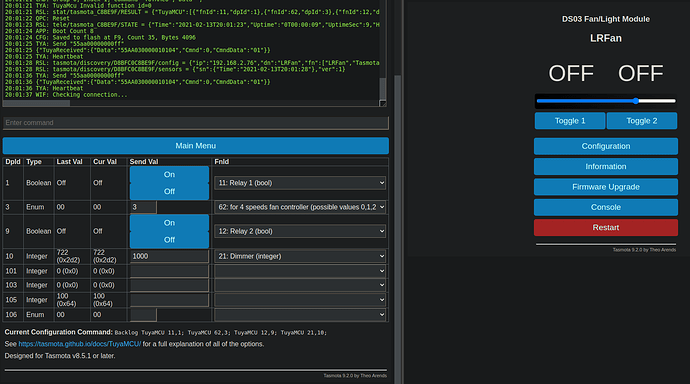I have a big spiel about my quest to get this switch integrated into my HE (which I posted in depth here) [side note, if it’s bad juju to link to another community, I’ll remove that link; I mean no disrespect!], which sent me off on a rabbit trail of looking into Home Assistant for MQTT support, and perusing here (where I learned that there is a “new hub” in development, I think? I need to read more, but it seems like it’ll be something similar to HE but with Wifi device support as well? I’m thoroughly intrigued, but I digress…).
Here’s the point. These switches use the TuyaMCU stuff that Tasmota seems to work with, kinda sort of, for the most part. I’ve managed to get my treatlife single-pole, 3-ways, dimmers, all up and running, but this damn fan controller is driving me insane. @markus’s driver and app are beyond phenomenal in this entire endeavor, but it seems there’s a slight hiccup with how Tasmota interacts with the TuyaMCU for “enum DpIDs,” evident in the fact that even when using the DS03 template, the GUI can’t change the fan speeds, as described here. The template setup uses the TuyaMCU serial commands to then publish MQTT posts on the fan speed status.
One of the latest updates to Tasmota, version 9.2, states that they’ve added support for TuyaMCU enum stuff (found here). Would it be overly difficult to “cut and paste” the HE integration from the 8.5 version of Tasmota I’m using now into the 9.2 version that supports the enum stuff? Or would markus’s T4HE work with the “stock” Tasmota 9.2?
Of course, this assumes Tasmota 9.2 actually operates the switch properly in the first place. I’m at work and can’t flash and test this stuff at the moment (this will be today’s after-work-project). Looking at the logs in the console on the 8.5 version, it seems the “0-3” buttons that are on the GUI for fan control (after mapping them via the TuyaMCU 3,61 command) send the command “Group 0, Index 2, Command “TUYASEND”, DATA 3,#”, the # being whatever speed you selected from 0-3. This doesn’t do anything because Tasmota uses TuyaSend4 to operate the enum stuff. If you use TuyaSend4 3,# in the console, the switch responds as it should.
So, circling back to the beginning, kind of, if T4HE essentially uses commands like the GUI would, then adding the fan to HE via the fan control child driver wouldn’t fully accomplish the goal because swapping speeds would just send “TuyaSend” commands, which would get ignored. Again, I’m not sure if this is corrected in Tasmota 9.2, and if it is, then integrating the HE elements into that version of Tasmota (essentially upgrading the "Tasmota with HttpHook by Oh-La Labs to the 9.2 version would alleviate this) would fix all of this.
… I think. I’m a “power-tinkerer” at best and a complete novice at all-things coding, so maybe I’m just talking out of my ass. And, as always, this gets horrendously long-winded so I’ll end it here. If anybody has any advice, tips, input, thoughts, or anything of the like, it would be greatly appreciated. ![]()

 ).
).

